Jiazheng Xing
OptMark: Robust Multi-bit Diffusion Watermarking via Inference Time Optimization
Aug 29, 2025Abstract:Watermarking diffusion-generated images is crucial for copyright protection and user tracking. However, current diffusion watermarking methods face significant limitations: zero-bit watermarking systems lack the capacity for large-scale user tracking, while multi-bit methods are highly sensitive to certain image transformations or generative attacks, resulting in a lack of comprehensive robustness. In this paper, we propose OptMark, an optimization-based approach that embeds a robust multi-bit watermark into the intermediate latents of the diffusion denoising process. OptMark strategically inserts a structural watermark early to resist generative attacks and a detail watermark late to withstand image transformations, with tailored regularization terms to preserve image quality and ensure imperceptibility. To address the challenge of memory consumption growing linearly with the number of denoising steps during optimization, OptMark incorporates adjoint gradient methods, reducing memory usage from O(N) to O(1). Experimental results demonstrate that OptMark achieves invisible multi-bit watermarking while ensuring robust resilience against valuemetric transformations, geometric transformations, editing, and regeneration attacks.
Cyc3D: Fine-grained Controllable 3D Generation via Cycle Consistency Regularization
Apr 21, 2025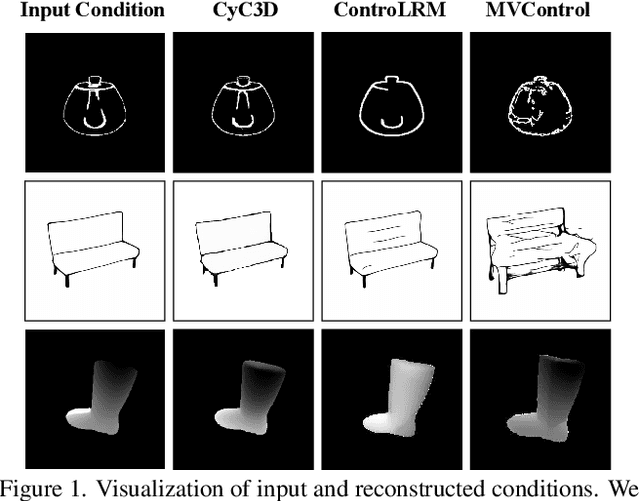



Abstract:Despite the remarkable progress of 3D generation, achieving controllability, i.e., ensuring consistency between generated 3D content and input conditions like edge and depth, remains a significant challenge. Existing methods often struggle to maintain accurate alignment, leading to noticeable discrepancies. To address this issue, we propose \name{}, a new framework that enhances controllable 3D generation by explicitly encouraging cyclic consistency between the second-order 3D content, generated based on extracted signals from the first-order generation, and its original input controls. Specifically, we employ an efficient feed-forward backbone that can generate a 3D object from an input condition and a text prompt. Given an initial viewpoint and a control signal, a novel view is rendered from the generated 3D content, from which the extracted condition is used to regenerate the 3D content. This re-generated output is then rendered back to the initial viewpoint, followed by another round of control signal extraction, forming a cyclic process with two consistency constraints. \emph{View consistency} ensures coherence between the two generated 3D objects, measured by semantic similarity to accommodate generative diversity. \emph{Condition consistency} aligns the final extracted signal with the original input control, preserving structural or geometric details throughout the process. Extensive experiments on popular benchmarks demonstrate that \name{} significantly improves controllability, especially for fine-grained details, outperforming existing methods across various conditions (e.g., +14.17\% PSNR for edge, +6.26\% PSNR for sketch).
Visual Object Tracking across Diverse Data Modalities: A Review
Dec 13, 2024



Abstract:Visual Object Tracking (VOT) is an attractive and significant research area in computer vision, which aims to recognize and track specific targets in video sequences where the target objects are arbitrary and class-agnostic. The VOT technology could be applied in various scenarios, processing data of diverse modalities such as RGB, thermal infrared and point cloud. Besides, since no one sensor could handle all the dynamic and varying environments, multi-modal VOT is also investigated. This paper presents a comprehensive survey of the recent progress of both single-modal and multi-modal VOT, especially the deep learning methods. Specifically, we first review three types of mainstream single-modal VOT, including RGB, thermal infrared and point cloud tracking. In particular, we conclude four widely-used single-modal frameworks, abstracting their schemas and categorizing the existing inheritors. Then we summarize four kinds of multi-modal VOT, including RGB-Depth, RGB-Thermal, RGB-LiDAR and RGB-Language. Moreover, the comparison results in plenty of VOT benchmarks of the discussed modalities are presented. Finally, we provide recommendations and insightful observations, inspiring the future development of this fast-growing literature.
TryOn-Adapter: Efficient Fine-Grained Clothing Identity Adaptation for High-Fidelity Virtual Try-On
Apr 01, 2024



Abstract:Virtual try-on focuses on adjusting the given clothes to fit a specific person seamlessly while avoiding any distortion of the patterns and textures of the garment. However, the clothing identity uncontrollability and training inefficiency of existing diffusion-based methods, which struggle to maintain the identity even with full parameter training, are significant limitations that hinder the widespread applications. In this work, we propose an effective and efficient framework, termed TryOn-Adapter. Specifically, we first decouple clothing identity into fine-grained factors: style for color and category information, texture for high-frequency details, and structure for smooth spatial adaptive transformation. Our approach utilizes a pre-trained exemplar-based diffusion model as the fundamental network, whose parameters are frozen except for the attention layers. We then customize three lightweight modules (Style Preserving, Texture Highlighting, and Structure Adapting) incorporated with fine-tuning techniques to enable precise and efficient identity control. Meanwhile, we introduce the training-free T-RePaint strategy to further enhance clothing identity preservation while maintaining the realistic try-on effect during the inference. Our experiments demonstrate that our approach achieves state-of-the-art performance on two widely-used benchmarks. Additionally, compared with recent full-tuning diffusion-based methods, we only use about half of their tunable parameters during training. The code will be made publicly available at https://github.com/jiazheng-xing/TryOn-Adapter.
SDSTrack: Self-Distillation Symmetric Adapter Learning for Multi-Modal Visual Object Tracking
Mar 28, 2024


Abstract:Multimodal Visual Object Tracking (VOT) has recently gained significant attention due to its robustness. Early research focused on fully fine-tuning RGB-based trackers, which was inefficient and lacked generalized representation due to the scarcity of multimodal data. Therefore, recent studies have utilized prompt tuning to transfer pre-trained RGB-based trackers to multimodal data. However, the modality gap limits pre-trained knowledge recall, and the dominance of the RGB modality persists, preventing the full utilization of information from other modalities. To address these issues, we propose a novel symmetric multimodal tracking framework called SDSTrack. We introduce lightweight adaptation for efficient fine-tuning, which directly transfers the feature extraction ability from RGB to other domains with a small number of trainable parameters and integrates multimodal features in a balanced, symmetric manner. Furthermore, we design a complementary masked patch distillation strategy to enhance the robustness of trackers in complex environments, such as extreme weather, poor imaging, and sensor failure. Extensive experiments demonstrate that SDSTrack outperforms state-of-the-art methods in various multimodal tracking scenarios, including RGB+Depth, RGB+Thermal, and RGB+Event tracking, and exhibits impressive results in extreme conditions. Our source code is available at https://github.com/hoqolo/SDSTrack.
FaceChain-ImagineID: Freely Crafting High-Fidelity Diverse Talking Faces from Disentangled Audio
Mar 04, 2024



Abstract:In this paper, we abstract the process of people hearing speech, extracting meaningful cues, and creating various dynamically audio-consistent talking faces, termed Listening and Imagining, into the task of high-fidelity diverse talking faces generation from a single audio. Specifically, it involves two critical challenges: one is to effectively decouple identity, content, and emotion from entangled audio, and the other is to maintain intra-video diversity and inter-video consistency. To tackle the issues, we first dig out the intricate relationships among facial factors and simplify the decoupling process, tailoring a Progressive Audio Disentanglement for accurate facial geometry and semantics learning, where each stage incorporates a customized training module responsible for a specific factor. Secondly, to achieve visually diverse and audio-synchronized animation solely from input audio within a single model, we introduce the Controllable Coherent Frame generation, which involves the flexible integration of three trainable adapters with frozen Latent Diffusion Models (LDMs) to focus on maintaining facial geometry and semantics, as well as texture and temporal coherence between frames. In this way, we inherit high-quality diverse generation from LDMs while significantly improving their controllability at a low training cost. Extensive experiments demonstrate the flexibility and effectiveness of our method in handling this paradigm. The codes will be released at https://github.com/modelscope/facechain.
M2-CLIP: A Multimodal, Multi-task Adapting Framework for Video Action Recognition
Jan 22, 2024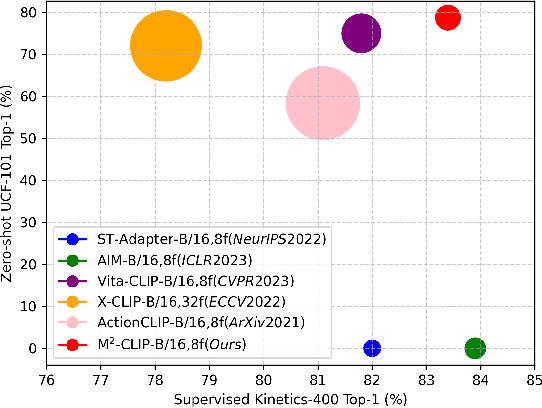
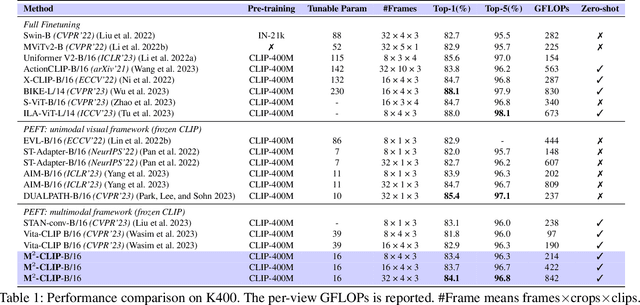

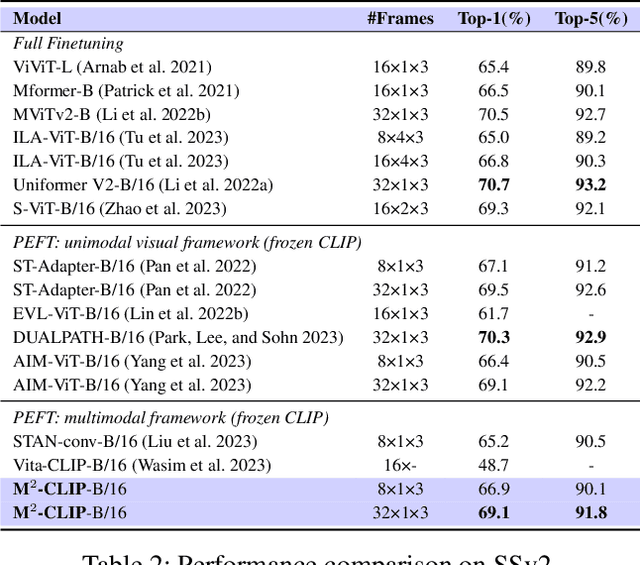
Abstract:Recently, the rise of large-scale vision-language pretrained models like CLIP, coupled with the technology of Parameter-Efficient FineTuning (PEFT), has captured substantial attraction in video action recognition. Nevertheless, prevailing approaches tend to prioritize strong supervised performance at the expense of compromising the models' generalization capabilities during transfer. In this paper, we introduce a novel Multimodal, Multi-task CLIP adapting framework named \name to address these challenges, preserving both high supervised performance and robust transferability. Firstly, to enhance the individual modality architectures, we introduce multimodal adapters to both the visual and text branches. Specifically, we design a novel visual TED-Adapter, that performs global Temporal Enhancement and local temporal Difference modeling to improve the temporal representation capabilities of the visual encoder. Moreover, we adopt text encoder adapters to strengthen the learning of semantic label information. Secondly, we design a multi-task decoder with a rich set of supervisory signals to adeptly satisfy the need for strong supervised performance and generalization within a multimodal framework. Experimental results validate the efficacy of our approach, demonstrating exceptional performance in supervised learning while maintaining strong generalization in zero-shot scenarios.
Boosting Few-shot Action Recognition with Graph-guided Hybrid Matching
Aug 18, 2023Abstract:Class prototype construction and matching are core aspects of few-shot action recognition. Previous methods mainly focus on designing spatiotemporal relation modeling modules or complex temporal alignment algorithms. Despite the promising results, they ignored the value of class prototype construction and matching, leading to unsatisfactory performance in recognizing similar categories in every task. In this paper, we propose GgHM, a new framework with Graph-guided Hybrid Matching. Concretely, we learn task-oriented features by the guidance of a graph neural network during class prototype construction, optimizing the intra- and inter-class feature correlation explicitly. Next, we design a hybrid matching strategy, combining frame-level and tuple-level matching to classify videos with multivariate styles. We additionally propose a learnable dense temporal modeling module to enhance the video feature temporal representation to build a more solid foundation for the matching process. GgHM shows consistent improvements over other challenging baselines on several few-shot datasets, demonstrating the effectiveness of our method. The code will be publicly available at https://github.com/jiazheng-xing/GgHM.
Multimodal Adaptation of CLIP for Few-Shot Action Recognition
Aug 03, 2023



Abstract:Applying large-scale pre-trained visual models like CLIP to few-shot action recognition tasks can benefit performance and efficiency. Utilizing the "pre-training, fine-tuning" paradigm makes it possible to avoid training a network from scratch, which can be time-consuming and resource-intensive. However, this method has two drawbacks. First, limited labeled samples for few-shot action recognition necessitate minimizing the number of tunable parameters to mitigate over-fitting, also leading to inadequate fine-tuning that increases resource consumption and may disrupt the generalized representation of models. Second, the video's extra-temporal dimension challenges few-shot recognition's effective temporal modeling, while pre-trained visual models are usually image models. This paper proposes a novel method called Multimodal Adaptation of CLIP (MA-CLIP) to address these issues. It adapts CLIP for few-shot action recognition by adding lightweight adapters, which can minimize the number of learnable parameters and enable the model to transfer across different tasks quickly. The adapters we design can combine information from video-text multimodal sources for task-oriented spatiotemporal modeling, which is fast, efficient, and has low training costs. Additionally, based on the attention mechanism, we design a text-guided prototype construction module that can fully utilize video-text information to enhance the representation of video prototypes. Our MA-CLIP is plug-and-play, which can be used in any different few-shot action recognition temporal alignment metric.
Revisiting the Spatial and Temporal Modeling for Few-shot Action Recognition
Jan 19, 2023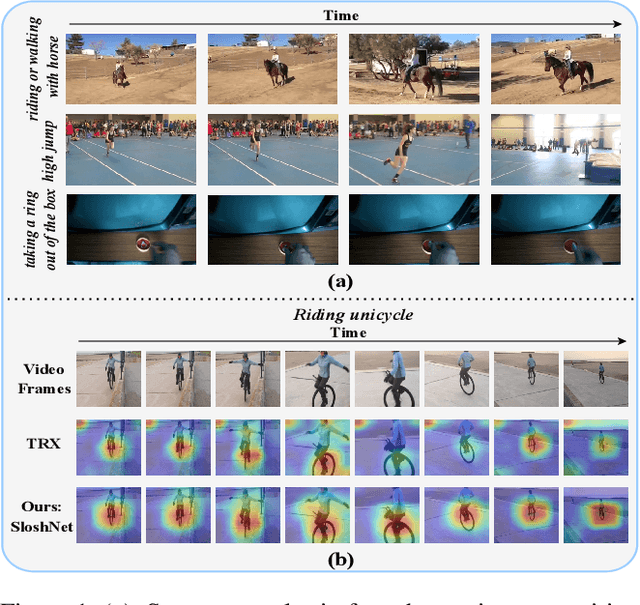


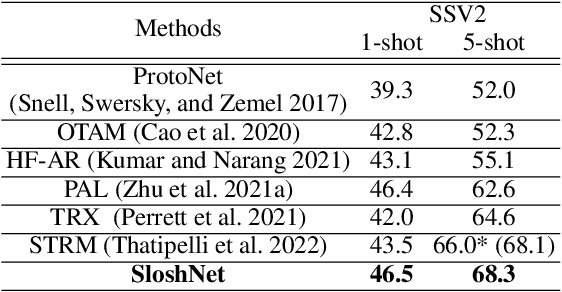
Abstract:Spatial and temporal modeling is one of the most core aspects of few-shot action recognition. Most previous works mainly focus on long-term temporal relation modeling based on high-level spatial representations, without considering the crucial low-level spatial features and short-term temporal relations. Actually, the former feature could bring rich local semantic information, and the latter feature could represent motion characteristics of adjacent frames, respectively. In this paper, we propose SloshNet, a new framework that revisits the spatial and temporal modeling for few-shot action recognition in a finer manner. First, to exploit the low-level spatial features, we design a feature fusion architecture search module to automatically search for the best combination of the low-level and high-level spatial features. Next, inspired by the recent transformer, we introduce a long-term temporal modeling module to model the global temporal relations based on the extracted spatial appearance features. Meanwhile, we design another short-term temporal modeling module to encode the motion characteristics between adjacent frame representations. After that, the final predictions can be obtained by feeding the embedded rich spatial-temporal features to a common frame-level class prototype matcher. We extensively validate the proposed SloshNet on four few-shot action recognition datasets, including Something-Something V2, Kinetics, UCF101, and HMDB51. It achieves favorable results against state-of-the-art methods in all datasets.
 Add to Chrome
Add to Chrome Add to Firefox
Add to Firefox Add to Edge
Add to Edge